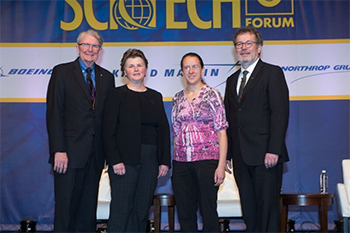Design and Visualization Move Into New Virtual Worlds Written 11 January 2018
Panelists: Moderator David E. Bowles, director, NASA’s Langley Research Center; August Noevere, aerospace research engineer, Collier Research Corp. — HyperSizer Software; Adam Clark, aerodynamics engineer, Enabling Technology & Research, Boeing Commercial Airplanes; Thomas Convard, technical product manager, Epic Games; Rodney Martin, deputy data sciences group lead, NASA’s Ames Research Center; Rachel Narciso, immersive technology specialist, Ball Aerospace
by Hannah Godofsky, AIAA Communications

Design and visualization environments are changing fast, and digital natives are changing design environments, panelists said Jan. 11 during the “Digital Natives Leading the Digital Transformation in Design and Knowledge Environments” session at the 2018 AIAA SciTech Forum in Kissimmee, Florida.
Virtual and augmented reality, analysis-based certification processes, and using video game engines to perform simulations are a few new technologies panelists discussed.
“Virtual reality and augmented reality are here to stay. It’s emerging as an affordable and attainable solution,” said Rachel Narciso, an immersive technology specialist at Ball Aerospace. “As a mechanical engineer, I do a lot of my design on a 2-D screen doing CAD with a mouse and a keyboard. I see a lot of benefit from stepping into a VR headset and doing it with my hands.”
She said VR could be used train workers on cleanroom techniques or to save time and money on business travel by using it as a means to collaborate. Narciso admitted that VR is still limited but emphasized it could be very useful in the space industry.
“If we’re coming up with a new, novel idea, we can’t test that in its exact environment,” she said. “We have to simulate that.”
Panelists said aircraft companies are interested in moving to analysis-based certification processes.
“Airplane certification is one of the largest nonrecurring cost-drivers in a commercial airplane development program,” said Adam Clark, an aerodynamic engineer at Boeing Commercial Airplanes. “(Computational fluid dynamics) is going to play an increasing role in the future — using computers instead of having to fly everything. We can move toward simulating a lot of this.”
Thomas Convard, technical project manager at Epic Games, said companies are using the Unreal video game engine to do simulation in technical fields.
“Architects are using the game engine for simulation and VR,” he said, showing demos of gleaming glass condos along the Miami beachfront simulated using the game engine.
Convard explained many customers in aerospace, architecture and automotive are using the Unreal engine because an off-the-shelf product comes with a cost advantage and can be implemented on a larger scale.
“This used to be really expensive software, but now you can go to Best Buy and get a headset and start doing VR at your facility,” he said. “We can do this at a mass scale instead of having one VR center.”
